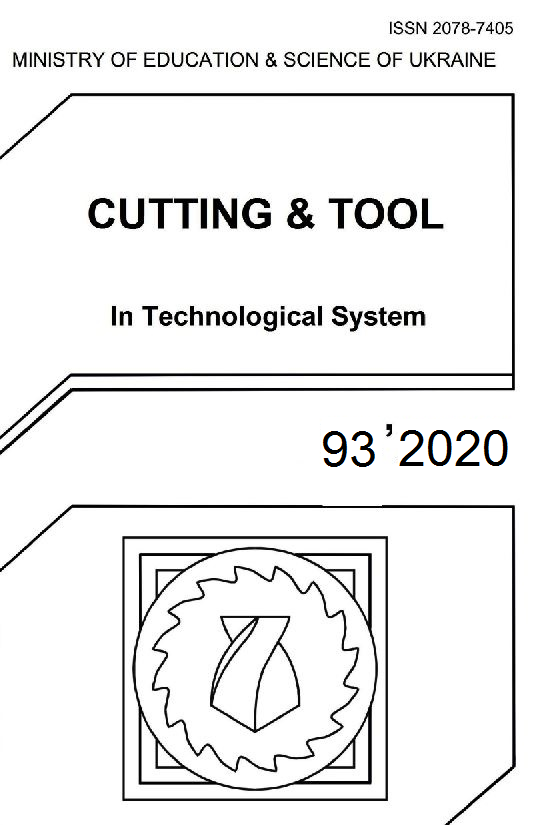DESIGNATION OF EVALUATION AREA IN MEASURING 3D SURFACE ROUGHNESS
DOI:
https://doi.org/10.20998/2078-7405.2020.93.07Keywords:
surface roughness, Sa, Ssk, , hard turning, grinding.Abstract
In the automotive industry surface topography is an important issue. The working surfaces of the components require high precision machining. In this paper the minimum 3D roughness evaluation areas were determined to decrease the time and cost of measuring the components.References
Vasvay, L., Ditroi, F., Takacs, S., Szabo, Z., Szucs, J., Kundrak, J., Mahunka, I.: Wear Measurement of the Cutting Edge of Superhard Turning Tools using TLA Technique, Nuclear Instruments & Methods in Physics Research, No.85, 1994, pp.255–259.
Mamalis, A.G., Kundrak, J., Horvath, M.: On a Novel Tool Life Relation for Precision Cutting Tools, Journal of Manufacturing Science and Engineering – Transactions of the ASME, Vol.127 No.2, 2005, pp.328–332.
Kundrak, J., Gyani, K., Bana, V.: Roughness of Ground and Hard-Turned Surfaces on the Basis of 3D Parameters, International Journal of Advanced Manufacturing Technology, Vol.38, No.1-2, 2008, pp.110–119.
Schmahling, J., Hamprecht, F.A., Hoffmann, D.M.P.: A Three-Dimensional Measure of Surface Roughness based on Mathematical Morphology, Technical Report from Multidimensional Image Processing, IWR, 2006, University of Heidelberg.
Legutko, S., Zak, K., Kudlacek, J.: Characteristic of Geometric Structure of the Surface after Grinding, MATEC Web of Conferences, 2007, 02007.
Struzikiewicz, G., Sioma, A.: Evaluation of Surface Roughness and Defect Formation after the Machining of Sintered Aluminum Alloy AlSi10Mg, Materials, No.13, 2020.
Matras, A., Zębala, W., Machno, M.: Research and Method of Roughness Prediction of a Curvilinear Surface after Titanium Alloy Turning, Materials, Vol.12, No.3, 502.
Nadolny, K., Kaplonek, W.: Analysis of Flatness Deviations for Austenitic Stainless Steel Workpieces after Efficient Surface Machining, Measurement Science Review, Vol.14, No.4, 2014.
Kundrak, J., Nagy, A., Markopoulos, A.P., Karkalos, N.E.: Investigation of Surface Roughness on Face Milled Parts with Round Insert in Planes Parallel to the Feed at Various Cutting Speed, Rezanie i Instrumenty v Tekhnologicheskih Sistemah, Vol.91, No.1, 2019, pp.87–96.
Deltombe, R., Kubiak, K.J., Bigerelle, M.: How to Select the Most Relevant 3D Roughness Parameters of a Surface? Scanning, Vol.36, No.1, 2014, pp.150–160.
Grzesik, W., Zak, K., Kiszka, P.: Comparison of Surface Textures Generated in Hard Turning and Grinding Operations, Procedia CIRP, No.13, 2014, pp.84–89.
Grzesik, W., Rech, J., Zak, K.: High-Precision Finishing Hard Steel Surfaces Using Cutting, Abrasive and Burnishing Operations, Procedia Manufacturing, Vol.1, 2015, pp.619–627.
Wojciechowski, S., Twardowski, P., Chwalczuk, T.: Surface Roughness Analysis after Machining of Direct Laser Deposited Tungsten Carbide, Journal of Physics: Conference Series, 483, 2014, 012018.
Zawada-Tomkiewicz, A.: Analysis of Surface Roughness Parameters Achieved by Hard Turning with the Use of PCBN Tools, Estonian Journal of Engineering, Vol.17, No.1, 2011, pp.88–99.
Pytlak, B.: The Roughness Parameters 2D and 3D and Some Characteristics of the Machined Surface Topography after Hard Turning and Grinding of Hardened 18CrMo4 Steel, Komisja Budowy Maszyn Pan – Oddzial w Poznaniu, Vol.31, No.4, 2011, pp.53–62.
Abouelatta, O.B.: 3D Surface Roughness Measurement Using a Light Sectioning Vision System, Proceedings of the World Congress on Engineering 2010 Vol.1, 2010.
Shivanna, D.M., Kiran, M.B., Kavitha, S.D: Evaluation of 3D Surface Roughness Parameters of EDM Components Using Vision System, Procedia Materials Science, No.5, 2014, pp.2132–2141.
Downloads
Published
Issue
Section
License
Copyright Notice
Authors who publish with this Collection agree to the following terms:
1. Authors retain copyright and grant the Collection right of first publication with the work simultaneously licensed under a Creative Commons Attribution License that allows others to share the work with an acknowledgement of the work's authorship and initial publication in this Collection.
2. Authors are able to enter into separate, additional contractual arrangements for the non-exclusive distribution of the Collection's published version of the work (e.g., post it to an institutional repository or publish it in a book), with an acknowledgement of its initial publication in this Collection.
3. Authors are permitted and encouraged to post their work online (e.g., in institutional repositories or on their website) prior to and during the submission process, as it can lead to productive exchanges, as well as earlier and greater citation of published work.

